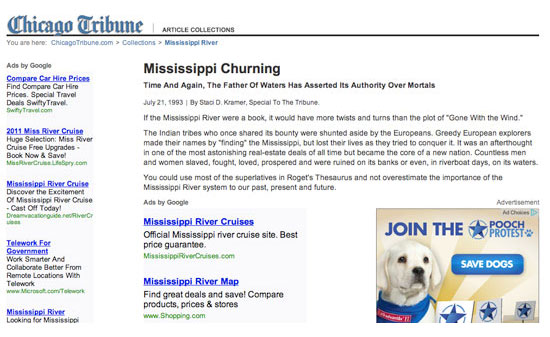Sign up for the daily CJR newsletter.
Watching the Mississippi River spill deeper into downtown Memphis than it has in my lifetime, I went in search of something I wrote during the 1993 flood between the breaking stories–an essay about the river’s power, ordered by an editor at the Chicago Tribune who thought people needed a history lesson. It took less than a minute to find the eighteen-year-old article by googling “Mississippi River” and my byline. I also found another kind of history lesson–and a current events one, too.
Back in those days, whenever I wrote for the Tribune, my Chicago friends and family would pass the word to one another. The Sun-Times side would bend enough to pick up copies of the other paper; the Tribune subs would check their home-delivered editions, maybe send the section or a clipping to my parents. I would go to World News in downtown Clayton, Mo., to buy my own copies of the printed results. I could get some news by computer in those pre-web days, but print ruled.
As an independent journalist, I also could work for news outlets with different publication schedules without much conflict. A couple of dailies, a weekly, a monthly. That wouldn’t be possible today. No matter when they appear in print, they all compete in digital time.
That was the history lesson. The current events counterpart was what came up with that Google link. Page two of a story that had been SEO’d within an inch of its life, chopped into four pages–at least three with separate Google links.
What had been a carefully, almost beautifully laid-out print article–or something that was at least readable in the archives–was in something called “collections” now laden with Google ads: five in the left-hand rail, two in the middle of the text, (including one for Mississippi River cruises), one below plus a top line from an ad network and an eBay daily deals display ad. Three story links showed up, none more recent than 2002, despite the intense news interest in the Mississippi River now.

An article that once upon a time would have disappeared into the morgue is readily available–and almost unreadable as the Tribune tries to wring every long-tail penny possible out of its archives.
It’s fitting that my own reading the last few days has been a new report from the Columbia University Graduate School of Journalism: “The Story So Far: What We Know About the Business of Digital Journalism.” Writing for the Tow Center for Digital Journalism, Bill Grueskin, Ava Seave, and Lucas Graves tell the saga of digital journalism as a business (or a lack of one) from the mid-90s through now. It isn’t all dismal, but it isn’t pretty.
And one of the least attractive parts is what so many have done while they’re trying to figure out the business, or when they think they have–chasing the most incremental readers to get hyped traffic numbers to attract certain kinds of advertising or enough clicks to make dollars instead of pennies from Google ads and the like. Outwardly we like to complain about content farms; in reality, a lot of what news outlets are doing to the side of those front-page stories isn’t very different. (That’s not to knock optimizing for search; it’s hard to overestimate the value of doing it right in today’s cluttered content landscape.)
They are trying to make ubiquity and commodity news pay, to make the most out of the fly-bys. In the process, they often wind up making those of us who want to be there feel like we’d rather leave in a hurry. The Tow report looks, in part, at the value of focusing more deeply on some of those others, the regulars who connected by geography or drawn by passion read digital news with the same kind of engagement as newspaper readers. Matt Shanahan of Scout Analytics divides users into fans (at least twice a week), regulars (weekly), occasionals (two or thre times a month), and fly-bys (monthly).
At one 90,000-circ paper with a 450,000-montly-unique site, the fans and regulars totaled only 7 percent, while fly-bys were more than 75 percent. But the fans, four percent of the audience, made up more than 55 percent of the traffic–and generated 50 times more than the average fly-by.
Shanahan argues that it’s time for publishers to realize the value isn’t in traffic, it’s in the engagement of core users. Instead of making money chasing traffic, they are giving up the ad revenue they could get by serving better contextual ads to users they “know.”
That’s one of the real opportunities for publishers now implementing or looking at meters, subscriptions, and even micropayments. The most loyal readers or the ones with the most self-interest will pay. The numbers will be small but probably consistent and relatively price elastic as long as they can afford it. Advertisers, in most cases, will pay more to reach them than the masses as long publishers can tell them who they’re reaching.
So far, though, with the exception of some member clubs with benefits that too often could be for members of anything, many publishers seem to be doing little to serve those segments differently than the fly-bys. I’m not suggesting distinctly different products but maybe subscribers should get pages with fewer ads, for instance or be treated like regulars in other ways. That’s where efforts like The New York Times’s Recommendations can work.
At the same time, they have to work to find ways to shift some of the occasionals to regulars, to widen the group just enough–and to make sure the core doesn’t age out. That means making the most of someone’s interest when he or she finds one of those SEO links, treating them like a potential reader instead of just a click.
Has America ever needed a media defender more than now? Help us by joining CJR today.






